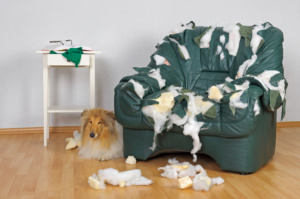
Sometimes, owners are not aware of the severity of their dog’s anxiety until they see a video.
Thank you to Maggie O’Brian, DVM of Rascal Animal Hospital for this guest article!
Separation anxiety is a common behavior problem seen in our canine companions. Certain dogs, whether due to genetics, lack of early socialization, or life experience, will experience distress when they are left without their human companions. It’s important to notice the symptoms of separation anxiety and help your pet with any distress they may experience.
What are common signs of separation anxiety in dogs?
Separation anxiety can look different between dogs. However, there are certain common signs that might alert you to a problem.
Dogs with separation anxiety will often become “worked up” as you get ready to depart. When you put your coat on or grab your keys or even start packing your lunch for the day, you might notice your dog panting, pacing, or following you around more closely than normal. Barking, howling, or whining may also increase as you prepare to leave and often, you may be able to hear your dog vocalizing as you walk to your car and pull out of the driveway.

Dogs will often chew on items to release anxiety.
You can find evidence of separation anxiety as you return from your time away. This can include destroyed items, such as blinds or shoes. In severe cases, dogs can chew at exit points, such as walls or doors. Dogs will often chew on items to release anxiety, much like some people will chew their finger nails when they are nervous. If dogs are truly panicked when you are away, they may defecate or urinate in your home. You may also notice wet spots in the house that can be from excess salivation.
If you are unsure if your pet has anxiety or not, you can set up a video recording, either on your laptop, iPad, or other device, to see what your pet does while you are away. Sometimes owners are not aware of the severity of their dog’s anxiety until they see a video.
What can I do to help my dog who may have separation anxiety?
The most important thing to do if you suspect your pet may have separation anxiety is to contact your veterinarian. Dogs with separation anxiety can harm themselves in a state of panic, not to mention it can have a massive impact on their quality of life. It is an issue that requires professional guidance. But more on that later…

Although difficult, wait until your pet calms down when you arrive, so you are rewarding calm behavior.
You should down play departures and arrivals with your anxious pet. When you are getting ready to leave, do not make a large fuss about going away, as this can increase your dog’s level of anxiety and anticipation of your departure. Downplaying arrivals is very difficult for many people. Many of us, including myself, love getting home to an excited dog and having a big celebration of the reunion. However, when you get home to a dog with separation anxiety, they are generally very stimulated from the stress of the day and by giving them massive amounts of affection, you are rewarding that anxious behavior. Although it is difficult, try to ignore your dog until he or she has calmed down, and at that point you can give affection to reward calm behavior.
Another thing you can do is create a safe space for your pet. Pick an area where you think your dog is most likely to spend time while you are away and make it a comforting spot. You can do this by playing classical music or specific dog calming music (http://throughadogsear.com/) or even just placing a box fan or noise cancelling machine in this area to decrease their sensitivity to any noise outside. You can provide a plug-in that releases pheromones proven to decrease anxiety (http://www.adaptil.com).
You can also provide an enriching food toy for your pet to eat while you are away. Pet stores, chewy.com, and amazon.com carry a wide variety of food puzzles. My personal favorite is simply to fill a Kong (https://www.kongcompany.com/) about 4/5 with dry kibble and then filling the remaining part of the Kong with peanut butter and freeze it over night for a delicious breakfast or dinner for your pet. Be sure to provide the safe space and toys while you are home as well, so preparing the toy and area does not become an indicator that you are leaving, as this can increase anxiety.
It is a common myth that getting another pet will help a dog with separation anxiety. This rarely improves the situation and can increase the amount of work and issues you must handle when you already have one anxious pet.
Who should I turn to for help if I believe my dog has separation anxiety?
If any of the symptoms of separation anxiety sound familiar to you, it is important to contact your veterinarian. Separation anxiety is a serious issue that can result in harm to your pet if they hurt themselves trying to escape, can cause serious damage to you home from destruction, and can significantly impact your pet’s quality of life. Your veterinarian can offer advice on how to best treat your pet.
Your vet may prescribe medication for your dog. Dogs with moderate to severe separation anxiety are often in a state of complete panic when you are gone. They are so panicked that they are often unable to benefit from the advice above until they have medication on board that can bring that level of panic down. Separation anxiety is a canine behavior problem that frequently requires medications as part of an overall treatment plan to make a significant impact.
Your veterinarian may also recommend that you seek help from a veterinary behaviorist, which is a veterinarian who has done three additional years of specialized training to handle animal behavior problems. In Ohio, we have one board certified veterinary behaviorist who sees cases at Ohio State (http://vet.osu.edu/vmc/companion/our-services/behavioral-medicine).
If you would like to submit a topic or specific question you would like for Dr. G to address in this blog, let us know by sending an email with Rascal’s Corner in the subject line.
Email to askDrG@generationwags.com
To view all posts in Rascal’s Corner click here!



